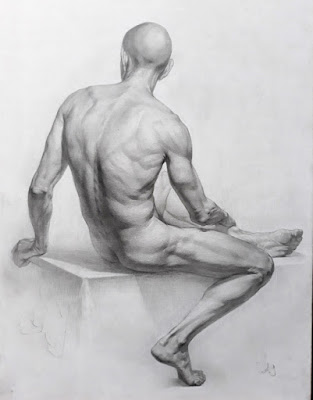He generously agreed to an interview.
 |
| Atmosphere at the Chiaro-Scuro art studio and atelier |
 |
| Foreshortened figure drawing by Robert Calo |
1. Academic drawing from life – these are long drawings whose purpose is to conduct a profound study of form. Here it is especially important to attentively define the shadow line, which is typically the primary tool to describe form.
2. Compositional drawing or, so called tonal cartoon, is made as a preliminary sketch for an exact compositional painting. Its main function is to cover big surfaces with the right tonality considering tonal gradation.
3. Quick sketch from life. The main objectives set for a quick sketch from life are the following: to express one’s first impression from a model, to quickly capture proportions and movement, to develop in the maximum possible way at least one detail for the sake of which this sketch is actually produced.
4. Anatomy drawing is aimed at profound studying of the structure of the human body, its bones and muscles. Such drawing is oftentimes linear and quite schematic with only a minimal modeling of the form via the shadow line. Each of the above mentioned types of drawing can be performed with the help of line and/or tone. Depending on the medium chosen and the individual manner of performance, drawing can be loose (painting like) or more graphic."
 |
| Foreshortened figure drawing by Sergey Chubirko |
Chubirko: "At our atelier “Chiaro-Scuro” in Florence, Italy, we normally produce different types of drawing in various mediums and manners. For example, graphite pencil is very good for studying of the form at the initial stages of art education as it is more controllable and less smudgy. It also enables the artist to approach the correct tonality by gradually adding tone. While graphite is wonderful for small and middle-sized formats, soft mediums, such as sepia, sanguine, charcoal etc. are ideal for big formats because tone can be applied much faster. I only recommend soft mediums for more experienced draftsmen, those who already know how to model the form and develop the detail."
Gurney: How is your thought process different for each of these types of drawing? Do you regard some of your drawings as a means to an end or are they all an end in themselves?
Chubirko: "The degree of completion depends on the purpose of the drawing. All drawings are important by themselves and are completed to the necessary degree. There is absolutely a different thought process for each category of drawing. For example, a drawing from imagination, which has an objective to visualise the idea of the artist, is different from, let’s say, a study from life, which is very much about depiction of nature as it is."
--- Part 2 tomorrow.
Chubirko's "Chiaro-Scuro" studio
Thanks, Shadrina Irina, for translating
Previously:
Fundamentals of Composition (English Edition
Fundamentals of Drawing (English Edition)
Fundamentals of Painting (English Edition)
Related books:
Anatomy of Human Figure: The Guide for Artists (Tan cover, below left, Russian Language)
Academic Drawings and Sketches (Blue cover, below right, Russian Language)
(Blue cover, below right, Russian Language)




Previous blog posts:
• Russian Books on Academic Drawing and Painting
Fundamentals of Drawing (English Edition)
Fundamentals of Painting (English Edition)
Related books:
Anatomy of Human Figure: The Guide for Artists (Tan cover, below left, Russian Language)
Academic Drawings and Sketches


Previous blog posts:
• Russian Books on Academic Drawing and Painting








2 comments:
Tnank you for doing this inteview James!!!
Thank you for sharing..atleast aside from european style we have this russian style of drawing
Post a Comment